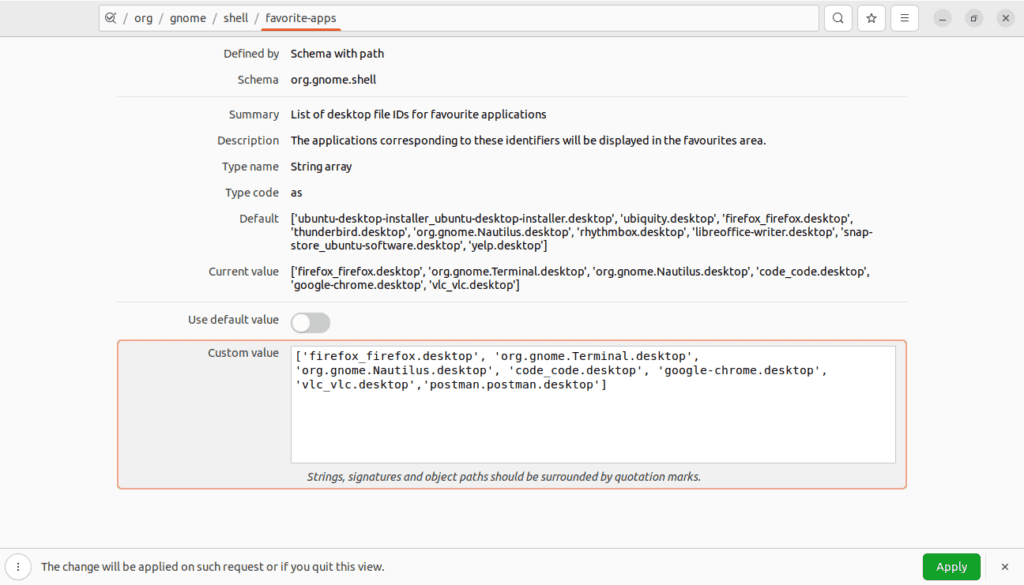1. Overview
The popular desktop environment GNOME provides an easy-to-use graphical user interface (GUI) for interacting with the operating system. As with other graphical environments, in GNOME, configuring favorites for faster access can be a common task.
In this tutorial, we’ll talk about the storage for GNOME favorites. Furthermore, we’ll discuss how to manage them.
2. GNOME Favorites Basics
Before we delve into specifics, let’s note that GNOME utilizes the dconf system to store its settings. To explain, dconf is a low-level configuration system that manages settings for the desktop environment by providing a centralized manner to handle configuration data. The dconf system is an important element of the GNOME desktop environment. It serves as a backend for storing key-value pairs that enable applications to preserve and manage their settings. dconf is essential for the GNOME shell, the core user interface of GNOME since it depends on this system to manage various settings including the ones related to favorites.
On the other hand, the term favorites refers to the commonly used applications pinned to the GNOME shell dash. To explain, the dash is a bar that typically appears on the left side of the screen to provide easy access to frequently used applications. As a result, we can launch these applications easily using a single click making navigation more efficient.
In GNOME, favorites are stored in the specific key org.gnome.shell within the dconf database. This key is found in the GNOME Shell Schema under favorite-apps and holds a list of desktop entry files corresponding to the favorite applications.
So, understanding this location enables us to view or modify our favorite applications directly.
3. Manage Favorites Using dconf
The dconf command-line tool helps to manage the GNOME settings directly from the terminal.
3.1. List Favorites
First, let’s show the list of current favorite applications:
$ dconf read /org/gnome/shell/favorite-apps
['org.gnome.Terminal.desktop', 'org.gnome.Nautilus.desktop', 'code_code.desktop', 'google-chrome.desktop', 'vlc_vlc.desktop']
There are two main parts to the command above:
- dconf read: reads the value of a specific key within the dconf database
- /org/gnome/shell/favorite-apps: represents the path to the specific key in the dconf database which holds the list of favorite applications in the GNOME shell
In this case, the output indicates that the favorite applications include GNOME Terminal, GNOME Files (Nautilus), Visual Studio Code, Google Chrome, and VLC media player.
3.2. Update Favorites
Next, let’s update the favorites applications list:
$ dconf write /org/gnome/shell/favorite-apps "['org.gnome.Terminal.desktop', 'firefox_firefox.desktop']"
This command updates the favorites list to only contain the GNOME Terminal and Firefox applications.
Notably, we can back up and restore the dconf settings using dconf.
4. Manage Favorites Using dconf-editor
The graphical tool dconf-editor facilitates both navigating and editing the dconf database.
4.1. Install and Run
First, we install this tool if it’s not already:
$ sudo apt install dconf-editor
When it comes to Debian-based systems, we use the apt package manager to install dconf-editor.
Next, let’s launch the tool from the terminal:
$ dconf-editor
Typing dconf-editor in the terminal and then pressing Return launches the tool.
4.2. Check Values
After dconf-editor opens, let’s click on the search icon, and paste the path /org/gnome/shell/favorite-apps:

Here, dconf-editor displays the desktop entry files for the current favorite applications.
4.3. Modify Values
At this point, let’s press Return and update the list of desktop entry files for a given path:

Here, we add the Postman application to the list of favorite applications. In particular, we add the desktop entry postman.postman.desktop within single quotes to the Custom Value list. Thereafter, the Apply button appears at the bottom to apply the modifications when clicked.
In addition, we can remove or reorder the entries to customize the GNOME favorites.
5. Conclusion
In this article, we discussed the location and management of GNOME favorites.
Understanding where GNOME favorites are stored enables us to manage them effectively. For instance, this knowledge provides a way to customize the GNOME shell environment based on preference to improve workflows. What’s more, we can utilize the dconf and dconf-editor tools to manage the favorites and ensure that the desktop environment is optimized for the current needs.